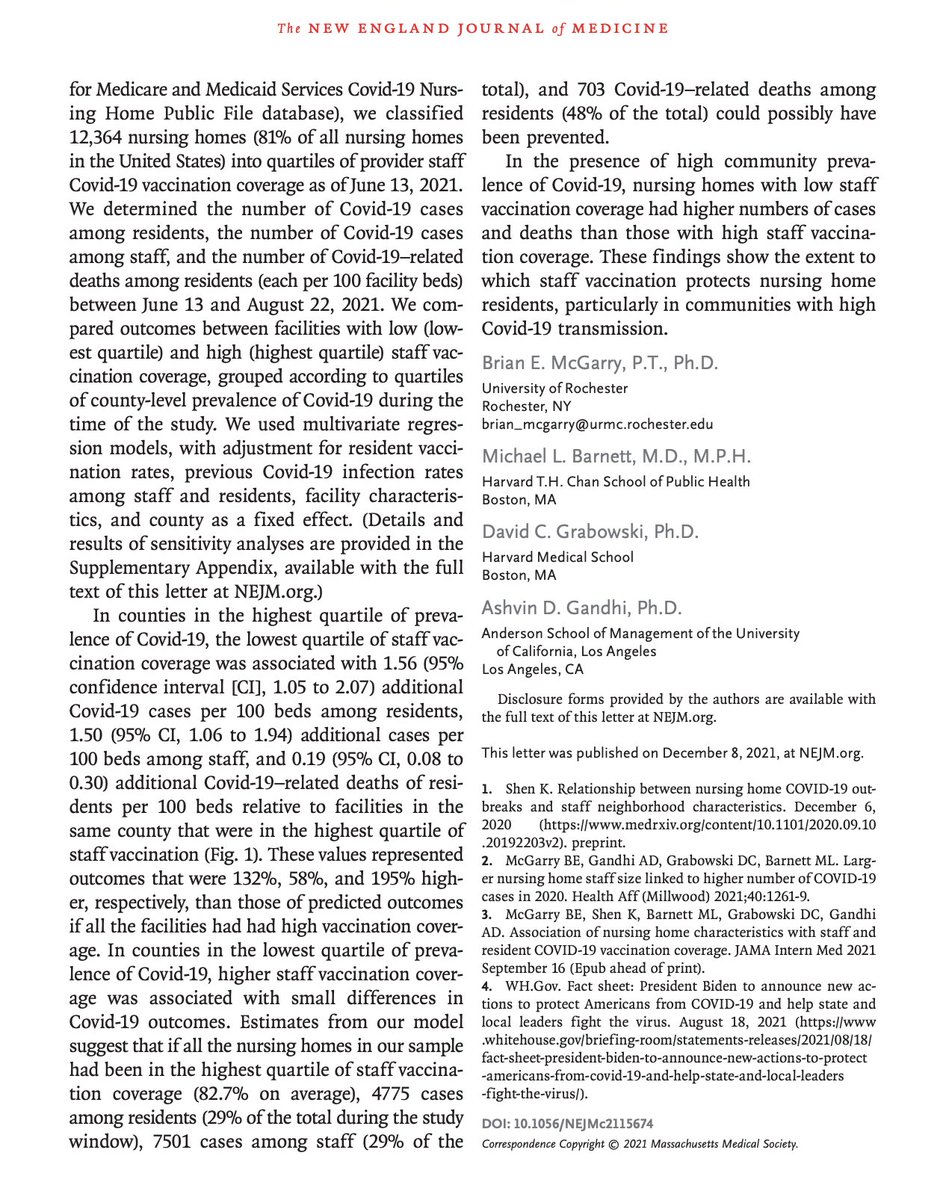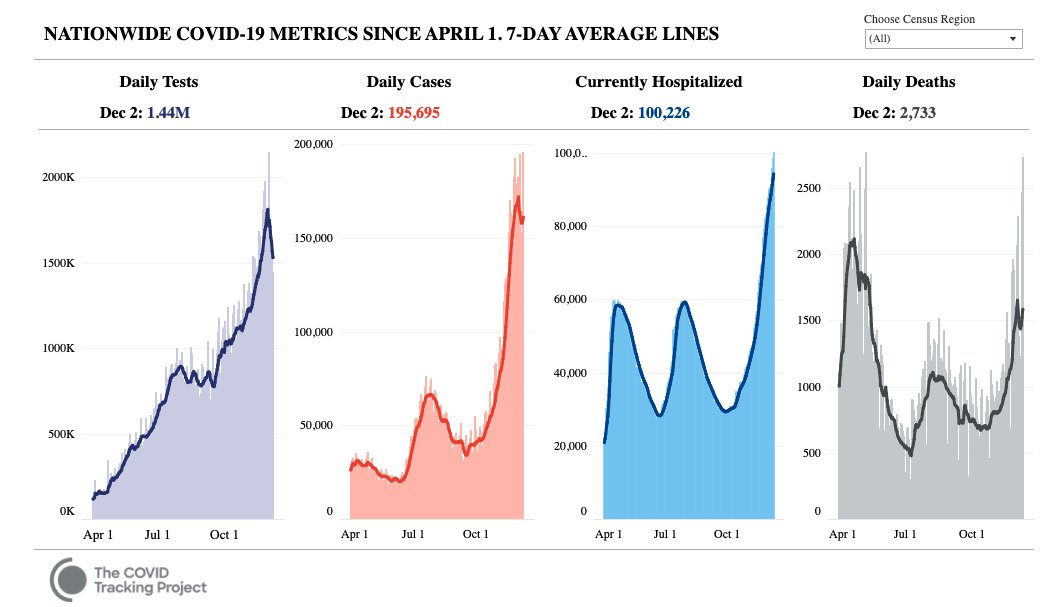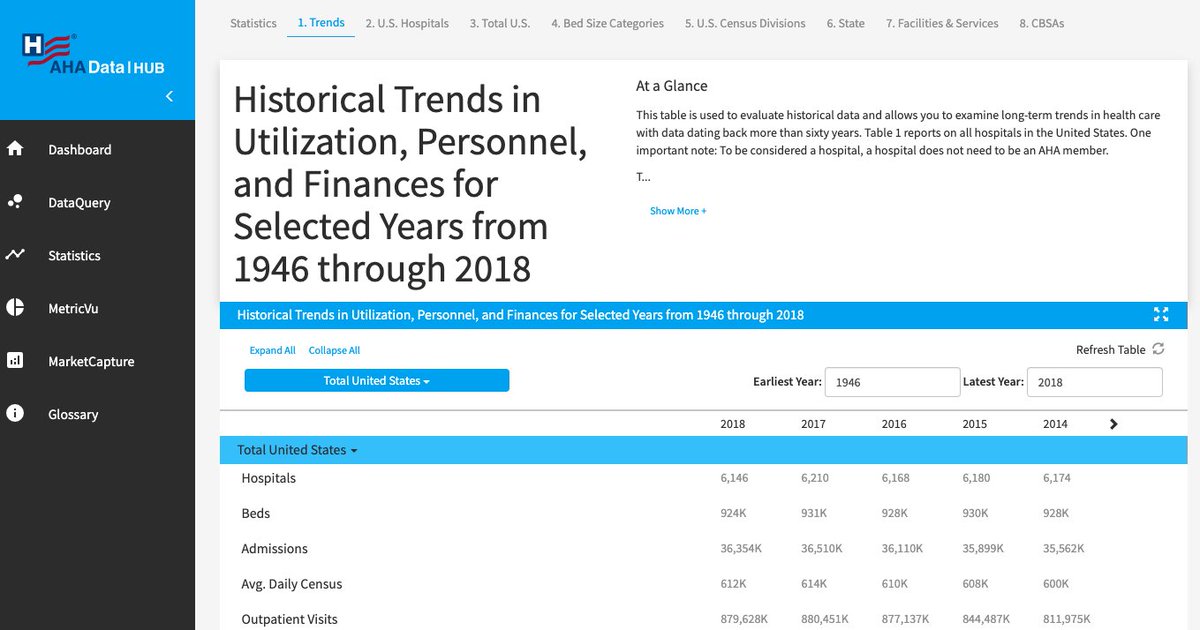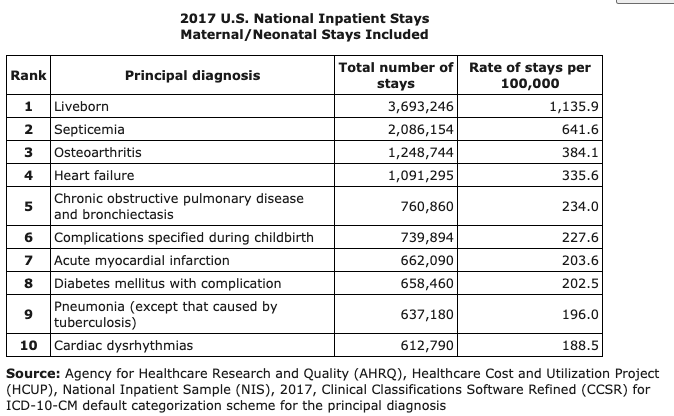
Here's my list of 12 papers in 2021 at the intersection of health care, medicine, economics and policy that surprised me, made me think, or were just damn clever.
I'm just going to focus on non-COVID-19 papers - we have enough of that other stuff in our feeds.
Off we go!
/1
I'm just going to focus on non-COVID-19 papers - we have enough of that other stuff in our feeds.
Off we go!
/1

Before we dive in - this is
A) definitely not comprehensive
B) definitely not in order of awesomeness
I’m also focusing on papers written by folks outside my direct circle of collaborators (w/ a couple of non-Harvard exceptions I can’t resist).
Sorry @AnupamBJena
/2
A) definitely not comprehensive
B) definitely not in order of awesomeness
I’m also focusing on papers written by folks outside my direct circle of collaborators (w/ a couple of non-Harvard exceptions I can’t resist).
Sorry @AnupamBJena
/2
@AnupamBJena The first set of papers falls under the theme of "obviously broken systems that we could fix and improve health."
Paper 1:
"SNAP Participation and Health Care User in Older Adults" led by Seth Berkowitz @UNC_SOM and @SanjaybMDPhD in @AnnalsofIM
acpjournals.org/doi/10.7326/M2…
Paper 1:
"SNAP Participation and Health Care User in Older Adults" led by Seth Berkowitz @UNC_SOM and @SanjaybMDPhD in @AnnalsofIM
acpjournals.org/doi/10.7326/M2…

@SanjaybMDPhD @AnnalsofIM They used North Carolina Medicaid claims to compare health care use 1 year before vs. after people enrolled in SNAP.
Hypothesis is that health and spending will improve NOT because of nutrition per se (too long-term) but because SNAP frees up income for other important things.

Hypothesis is that health and spending will improve NOT because of nutrition per se (too long-term) but because SNAP frees up income for other important things.


@SanjaybMDPhD @AnnalsofIM There were surprisingly huge effect sizes!
Decreases of ~10-20% in admissions/ED visits, big drops in spending and long-term care with SNAP.
I would have a hard time believing it but they were VERY thorough with alternative analyses (I expect no less from @SanjaybMDPhD).
Decreases of ~10-20% in admissions/ED visits, big drops in spending and long-term care with SNAP.
I would have a hard time believing it but they were VERY thorough with alternative analyses (I expect no less from @SanjaybMDPhD).

@SanjaybMDPhD @AnnalsofIM Paper 2:
"The Health Costs of Cost-Sharing" in @nberpubs by @amitabhchandra2 @oziadias and Evan Flack
They use an extremely clever (and complex) IV based on Medicare enrollment date to disentangle the health effects of higher cost sharing for drugs.
nber.org/system/files/w…

"The Health Costs of Cost-Sharing" in @nberpubs by @amitabhchandra2 @oziadias and Evan Flack
They use an extremely clever (and complex) IV based on Medicare enrollment date to disentangle the health effects of higher cost sharing for drugs.
nber.org/system/files/w…


@amitabhchandra2 @oziadias Byzantine Part D benefits lead to sharp cliffs with higher or lower drug costs. It's crazy.
With higher cost sharing, patients drop drug use indiscriminately and have substantially higher mortality.
You would get the opposite result with a naive OLS approach.


With higher cost sharing, patients drop drug use indiscriminately and have substantially higher mortality.
You would get the opposite result with a naive OLS approach.



Paper 3: "A Denial a Day Keeps the Doctor Away" in @nberpubs by @GottliebEcon @Pietro_Tebaldi @dj_sunchair @adamshap5
The authors quantify something all doctors know but few have quantified - the administrative hassle of insurance!
nber.org/system/files/w…

The authors quantify something all doctors know but few have quantified - the administrative hassle of insurance!
nber.org/system/files/w…


@nberpubs @GottliebEcon @Pietro_Tebaldi @dj_sunchair @adamshap5 Very sobering results.
25% of Medicaid claims have some item denied vs. <5% for commercial insurance leading to large revenue loss for docs billing Medicaid (on top of already low rates).
No surprise: docs who move to states with more Medicaid hassle stop accepting Medicaid


25% of Medicaid claims have some item denied vs. <5% for commercial insurance leading to large revenue loss for docs billing Medicaid (on top of already low rates).
No surprise: docs who move to states with more Medicaid hassle stop accepting Medicaid



Next up is the patient side of health care hassles
"Patient administrative burden in the US health care system" by @michaelannica @afrakt
in @HSR_HRET
They use a national survey to ask about administrative tasks patients have to do to get health care.
onlinelibrary.wiley.com/doi/full/10.11…
"Patient administrative burden in the US health care system" by @michaelannica @afrakt
in @HSR_HRET
They use a national survey to ask about administrative tasks patients have to do to get health care.
onlinelibrary.wiley.com/doi/full/10.11…

@michaelannica @afrakt @HSR_HRET It will surprise few that over 70% said they had to do some kind of administrative task for health care in the past year.
1 in 4 of these respondents had delayed or forgone care because of the hassle (not cost)
The shock is that we barely know anything about this issue at all!


1 in 4 of these respondents had delayed or forgone care because of the hassle (not cost)
The shock is that we barely know anything about this issue at all!



@HSR_HRET Another cool @HSR_HRET paper from @HNeprash @Laura2smith et al
"The effect of a public transportation expansion on no-show appointments"
No show rates are very stubborn - could public transportation help? They used a new light rail project to explore.
onlinelibrary.wiley.com/doi/10.1111/14…

"The effect of a public transportation expansion on no-show appointments"
No show rates are very stubborn - could public transportation help? They used a new light rail project to explore.
onlinelibrary.wiley.com/doi/10.1111/14…


@HSR_HRET @HNeprash @Laura2smith They found a 5% relative decline in no show rates for those living close to light rail vs. far away - especially for those on Medicaid (10% drop). For no show rates, that's actually kind of big.
This is a great example of thinking outside the box for health care access research

This is a great example of thinking outside the box for health care access research


Last on the list of obvious huge problems we aren't fixing: staff turnover at nursing homes.
The inimitable @ashdgandhi with @DavidCGrabowski @YuHuizi quantified just how bad it is in @Health_Affairs
This was an **EPIC** FOIA dataset snagged by Ashvin
healthaffairs.org/doi/10.1377/hl…
The inimitable @ashdgandhi with @DavidCGrabowski @YuHuizi quantified just how bad it is in @Health_Affairs
This was an **EPIC** FOIA dataset snagged by Ashvin
healthaffairs.org/doi/10.1377/hl…

@ashdgandhi @DavidCGrabowski @YuHuizi @Health_Affairs The situation is REALLY dire. The mean staff turnover rate was >100% annually in nursing homes. A completely untenable way to deliver high quality care.
Even scarier is that a non-trivial chunk of nursing homes had turnover >200% or 300%
This was all BEFORE Covid. Very bad.

Even scarier is that a non-trivial chunk of nursing homes had turnover >200% or 300%
This was all BEFORE Covid. Very bad.


@ashdgandhi @DavidCGrabowski @YuHuizi @Health_Affairs I'm going to take a break but come back later for 6 more papers on:
- Racial disparities
- Legit applications of AI/ML in health care
- Maternal health
- Racial disparities
- Legit applications of AI/ML in health care
- Maternal health
Next up: papers using AI/ML in a way that I think could really change practice.
First up is a @TheLancet paper by Karwath et al at @unibirmingham
"Redefining β-blocker response in heart failure patients"
It had a pre-registered analysis plan! Yay
thelancet.com/journals/lance…

First up is a @TheLancet paper by Karwath et al at @unibirmingham
"Redefining β-blocker response in heart failure patients"
It had a pre-registered analysis plan! Yay
thelancet.com/journals/lance…


@TheLancet @unibirmingham The authors harmonized data for >15,000 patients with CHF across 9 RCTs and used ML to identify distinct clusters of patients.
Efficacy of beta-blockers at reducing mortality varied a lot across groups! This is a great example of how we should leverage ML for causal inference.


Efficacy of beta-blockers at reducing mortality varied a lot across groups! This is a great example of how we should leverage ML for causal inference.



@TheLancet @unibirmingham Trust @oziadias to make this list again of course. Led by @2plus2make5 w/ @Cutler_econ @jure @m_sendhil in @NatureMedicine
"An algorithmic approach to reducing unexplained pain disparities"
Can we use ML to *reduce* bias in legacy medical algorithms?
nature.com/articles/s4159…

"An algorithmic approach to reducing unexplained pain disparities"
Can we use ML to *reduce* bias in legacy medical algorithms?
nature.com/articles/s4159…


@oziadias @2plus2make5 @Cutler_econ @jure @m_sendhil @NatureMedicine Why do black patients have worse pain from knee arthritis but more "normal" looking X-rays?
They toss out the legacy algo used to score X-rays and instead train an ML model to predict patient-reported PAIN from X-rays.
That model reduces the white-black pain gap by 43% - whoa
They toss out the legacy algo used to score X-rays and instead train an ML model to predict patient-reported PAIN from X-rays.
That model reduces the white-black pain gap by 43% - whoa

@oziadias @2plus2make5 @Cutler_econ @jure @m_sendhil @NatureMedicine This also has important implications for who is deemed eligible for joint replacement - DOUBLING the proportion of black patients potentially eligible.
This is a sterling example that picking the *right outcome* and *high quality data* is what makes a study great.
This is a sterling example that picking the *right outcome* and *high quality data* is what makes a study great.

Speaking of joint replacement, what are disparities in big surgical procedures like?
Drs. Best and Srikumaran @MGHSurgery @hopkinssurgery did a broad overview of surgery rates by race in the US from 2012-2017 in @JAMASurgery to look at this.
jamanetwork.com/journals/jamas…
Drs. Best and Srikumaran @MGHSurgery @hopkinssurgery did a broad overview of surgery rates by race in the US from 2012-2017 in @JAMASurgery to look at this.
jamanetwork.com/journals/jamas…

@MGHSurgery @hopkinssurgery @JAMASurgery I think the results are jaw dropping.
Compared to Black men, white men received:
- 133% more CABG procedures
- 141% more carotid endarterectomies
- 136% more heart valve replacements
No change at all from 2012-2017 and white/Black disparity persists within same insurance too

Compared to Black men, white men received:
- 133% more CABG procedures
- 141% more carotid endarterectomies
- 136% more heart valve replacements
No change at all from 2012-2017 and white/Black disparity persists within same insurance too


Next is a @JAMA_current paper by Dieleman et al from @IHME_UW
"US Health Care Spending by Race and Ethnicity, 2002-2016"
In IHME fashion, they combine dozens of years of federal survey data for a sweeping look at health care use by race nationally.
jamanetwork.com/journals/jama/…
"US Health Care Spending by Race and Ethnicity, 2002-2016"
In IHME fashion, they combine dozens of years of federal survey data for a sweeping look at health care use by race nationally.
jamanetwork.com/journals/jama/…

@JAMA_current @IHME_UW They show clearly how much racial groups diverge in health care use.
For example - Asians, Hispanic and Black patients use much less ambulatory care than whites. That is a structural fact.
Any health care system assuming otherwise is building in racial disparity by design.

For example - Asians, Hispanic and Black patients use much less ambulatory care than whites. That is a structural fact.
Any health care system assuming otherwise is building in racial disparity by design.


The last 2 are about maternal health. I loved this @JAMAHealthForum piece led by @carolinegeiger_ w/ @markaclapp @jessicaleecohen
They ask how maternal and perinatal outcomes change over the (very) arbitrary cutoff of 35 yrs for "advanced maternal age"
jamanetwork.com/journals/jama-…
They ask how maternal and perinatal outcomes change over the (very) arbitrary cutoff of 35 yrs for "advanced maternal age"
jamanetwork.com/journals/jama-…

@JAMAHealthForum @carolinegeiger_ @markaclapp @jessicaleecohen There's little question that the system follows this cutoff - look how sharply health care use changes around 35!
This increased vigilance may have had an impact - perinatal mortality was 0.4% lower over 35, a big effect (though imprecise at p=0.04)
So maybe there is underuse?

This increased vigilance may have had an impact - perinatal mortality was 0.4% lower over 35, a big effect (though imprecise at p=0.04)
So maybe there is underuse?


Finally, there was this amazing @NEJM trial by Teresa Hiller et al from @NWPermanente
This team compared two diagnostic approaches for gestational diabetes, 1-step or 2-step, that have very different sensitivity for diagnosis
Does it make a difference?
nejm.org/doi/full/10.10…
This team compared two diagnostic approaches for gestational diabetes, 1-step or 2-step, that have very different sensitivity for diagnosis
Does it make a difference?
nejm.org/doi/full/10.10…

@NEJM @NWPermanente There was an enormous diagnostic gap in the two random groups - 16.5% (1-step) vs. 8.5% (2-step). That's a really big difference!!
Amazingly enough, almost no maternal or perinatal outcome differed between the groups, including C-section rate.
That's a lot of overdiagnosis.

Amazingly enough, almost no maternal or perinatal outcome differed between the groups, including C-section rate.
That's a lot of overdiagnosis.


That's a wrap! 12 papers that I will remember from this year.
Health care can seem impossible to fix, but there is obvious low hanging fruit if we have the will to change it.
Thanks for reading and thanks to all of the authors for your hard work and grit with these papers.
Health care can seem impossible to fix, but there is obvious low hanging fruit if we have the will to change it.
Thanks for reading and thanks to all of the authors for your hard work and grit with these papers.
• • •
Missing some Tweet in this thread? You can try to
force a refresh


















